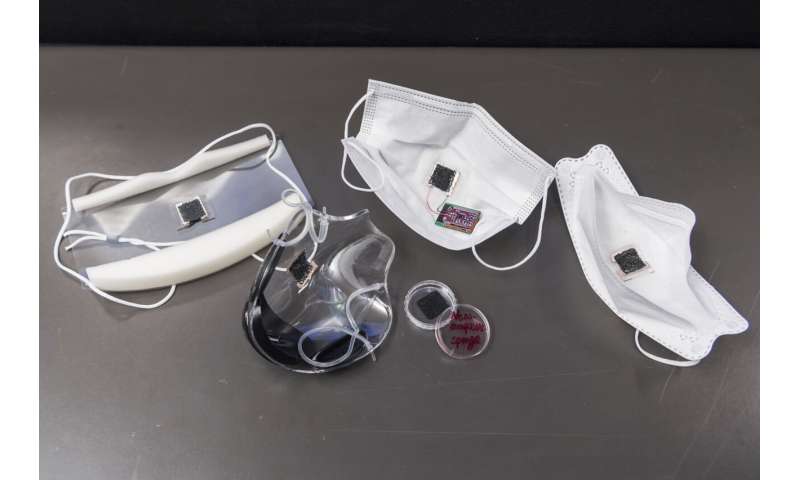Researchers invent smart mask to track respiratory sounds for respiratory disease identification

Wearing face masks has been recognized as one of the most effective ways to prevent the spread of COVID-19, even in its coming endemic phase. Apart from the conventional function of masks, the potential for smart masks to monitor human physiological signals is being increasingly explored. A research team led by the City University of Hong Kong (CityU) recently invented a smart mask, integrating an ultrathin nanocomposite sponge structure-based soundwave sensor, which is capable of detecting respiratory sounds of breathing, coughing and speaking.
Using machine-learning algorithms and a high sensitivity soundwave sensor operable across a wide bandwidth, the smart mask has opened new avenues for its application in the identification of respiratory diseases, as well as a voice interaction tool. This ultra-lightweight wearable technology also has the potential to improve personal and public health by enabling prolonged and systematic respiratory health monitoring in daily life.
A research team led by Professor Li Wenjung, Chair Professor in the Department of Mechanical Engineering (MNE), Professor Wang Jianping, Professor in the Department of Computer Science (CS), and Dr. Yu Xinge, Associate Professor in the Department of Biomedical Engineering (BME) at CityU, recently developed this smart mask, which can detect and distinguish multiple respiratory actions. Professor Shen Jiangang’s team from the School of Chinese Medicine of The University of Hong Kong also made an important contribution to the project. The findings were published in Advanced Science.
https://youtube.com/watch?v=eqlEiRi2vU0%3Fcolor%3Dwhite
Importance of wearing masks even if COVID-19 becomes endemic
“Many countries now believe that COVID-19 will soon become endemic,” said Professor Li. “However, we must set aside optimism and be realistic about the likely levels of illness, disability and death associated with this disease in the coming years. It is important to remember that endemicity does not correspond to harmlessness.”
He used malaria as an example to illustrate that even though it is currently considered endemic in 87 countries, in 2020, it infected an estimated 241 million people and caused 627,000 deaths, according to the World Health Organization. Thus, he suggested that people should continue to be cautious about COVID-19 and use available and proven measures, including masks, to control the spread of the virus.

“This smart mask utilizes our self-developed, high-sensitivity, wide-bandwidth flexible sensor that can detect and record daily human respiratory activity, such as breathing, coughing and speaking for cloud data storage,” explained Professor Li.
The smart mask developed by the team has a sponge-like structure as thin as 400μm, fabricated with carbon nanotube and polydimethylsiloxane (CNT/PDMS) materials, using the team’s novel modified sacrificial-release technique. The ultra-thin, lightweight sensor can be practically integrated and work effectively with both rigid masks and deformable non-woven fabric masks.
Good performance in static and dynamic pressure
The research team recruited 31 people in order to collect their respiratory activity while they wore the smart mask. The findings showed that the acoustic wave sensor was highly sensitive in measuring both static and dynamic pressure. Besides performing well in the static pressure range of 27.9 Pa–2.5 kPa, the sensor also responded to high-frequency dynamic pressure generated by the human voice, i.e., sound harmonic acoustic energy up to 4000 Hz.
In addition, the sensor can sense air movement, including directional flow and vibration. These findings suggest that the sensor could be used to detect human respiratory activity by integrating it with a commercial polycarbonate mask. It also demonstrated that the smart mask could detect and differentiate three common respiratory functions: breathing, coughing and speaking.
“Advanced artificial intelligence technology enables the integrated mask to recognize different coughing and breathing patterns automatically, indicating its potential use to diagnose respiratory-related diseases in the future,” said Professor Wang.
“Presently, researchers use commercial sensors to detect temperature changes and airflow to count the number of coughs, but they cannot capture important physiological information contained in the human voice, coughing and breathing. Our smart mask is sensitive to both subtle air pressure and high-frequency vibrations and can detect three phrases of coughing,” added Professor Li.
The team aims to eventually develop real-time diagnostics algorithms for applications such as pneumoconiosis symptom assessment. “As a potentially low-cost, daily smart wearable device, this new IoT smart mask will help personal and public health management of respiratory disease screening and diagnosis, especially in cities with a dense population, like Hong Kong,” said Dr. Yu. The speech-detection ability of the smart mask can also help resolve the sound attenuation problem caused by wearing masks.
More information:
Jiao Suo et al, Wide‐Bandwidth Nanocomposite‐Sensor Integrated Smart Mask for Tracking Multiphase Respiratory Activities, Advanced Science (2022). DOI: 10.1002/advs.202203565
Journal information:
Advanced Science
Source: Read Full Article


